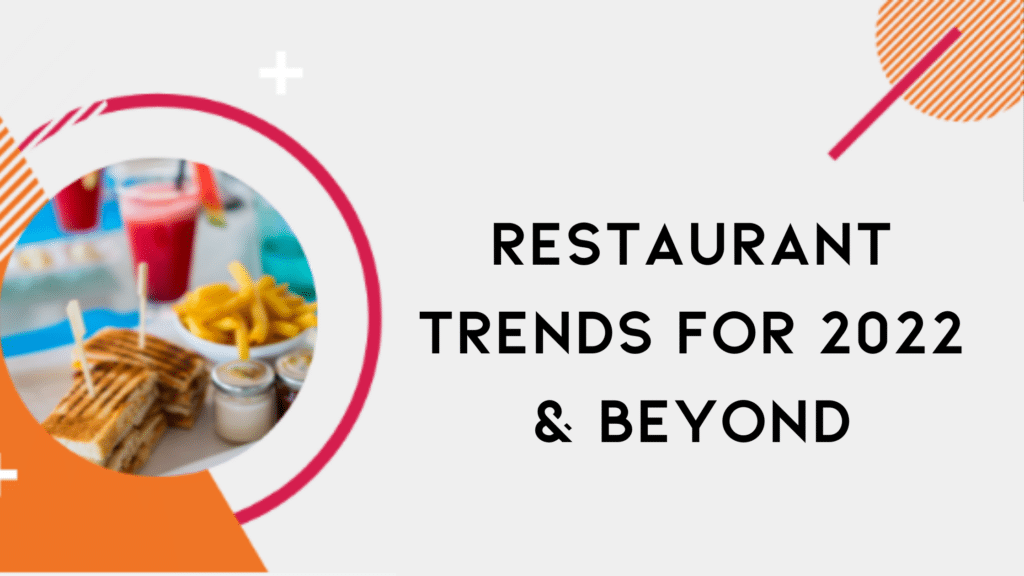As a restaurant owner it’s important to be aware of current and future restaurant trends. As one forecasts how the restaurant industry will look in 2022 and beyond, it’s helpful to take a look at the latest trends.
What are some of the restaurant trends in 2021? What restaurant trends can we expect as we approach 2022? How has quarantine affected these restaurant trends and are there any lasting impacts? Stay tuned as we’ll cover all these questions and more.
Lasting effects of COVID-19
COVID-19 and the related quarantine that took effect had a major impact on the restaurant industry as a whole. For many months restaurants survived on takeout orders and that method of service will not be going away anytime soon. On top of this takeout trend we’re also seeing consumers desiring more health-oriented options. Some notable dietary trends include vegetarianism and veganism alternatives.
Additionally, the quarantine forced some consumers to truly get creative with the ingredients they had on hand. As a result there has been a significant increase in home-made meals. In some cases these meals utilize a blend of home-made and restaurant takeout components. It’s also notable that home-baked breads have recently seen a resurgence as well.
Without question the COVID-19 quarantine has left its mark on the food industry. Some of these trends may change in the near future. But one thing is certain—they’re shining a light on aspects of the restaurant business that have not seen innovation in some time. These trends have also influenced the types of foods that consumers are now looking for.
Food trends
Consumers have a hunger for exploration and experimentation. This has resulted in an explosion of fusion dining. There’s also a rise in desire for health and environmentally conscious choices. This is leading consumers to especially seek out environmentally friendly establishments and meals.
Fusion dining
After a long period of containment, consumers are excited to experience the many joys of life that were previously taken for granted. One such element is the variety of foods available from all around the world. What better way to appreciate such great diversity than to consume creations that fuse elements of two or more different cultures into one delicious meal? Consumers are searching far and wide to experience foods from all different cultures. Many local restaurants are providing options to fulfill their desires. Are you considering traveling to the next town over for Korean BBQ? How about a visit to your local Mexican restaurant for some Mexican-Korean fusion?
Drink trends
In addition to the fusion dining experience, consumers are looking for unique and exciting drinks to accompany their meals. These range from non-alcoholic mocktails to alcohol-infused kombucha and seltzer. With the general rise in popularity of kombucha, it’s no wonder it has become more common in restaurant settings. However, the introduction of alcohol in these products is more of a social treat.
Whereas consumers would sit down to enjoy an alcoholic beverage with their friends, the alcohol-infused kombucha offers an alcohol experience with the promise of a health-conscious choice. Likewise, some consumers enjoy the taste offered by many mixed drinks but would like to pass on the side effects that come with consuming alcohol. That includes the potential health concerns. Thus the popularity of the mocktail.
Healthy and environmentally friendly food trends
While fusion dining is hot we are also seeing a massive rise in consumers seeking health and environmentally conscious options. As a result of the lockdown many individuals saw their body suffer from a significant reduction in activity. This has no doubt influenced their eating decisions moving forward as they attempt to lose weight and get their body back into shape. This is why we’re seeing a decrease in the demand for meat options. Instead consumers are opting for vegetarian and vegan options to reduce fat intake and increase variety in their meals.
Process trends
Restaurant owners are finding ways to improve current systems and processes to meet future expectations. Namely, we’re seeing a major focus on takeout ordering and significant innovations in the drive-thru.
As previously noted, takeout orders are at an all-time high. Consumers still utilize takeout options as a primary portal for their eating-out desires. Thus, we’re seeing takeout options appearing in previously eat-in-only settings.
Takeout areas
Many restaurants that struggled to remain profitable through the lockdown created makeshift takeout areas. In many cases these locations within the storefront utilized dining room space. Now that lockdown has ended, these areas have been minimized. Still, in many cases they’ve remained a permanent space within the restaurant. In some instances, restaurants have remodeled their facility to include a takeout window or separate waiting area for takeout orders.
Streamlined drive-thrus
Drive-thrus have always been a staple in the fast food industry. Yet, we are seeing tons of innovation to accommodate their increased usage during and after quarantine. With an increase in drive-thru sales, there’s been a decrease in lobby use at these locations. This reduces the need for large sit-down spaces to accommodate customers. As such many fast food restaurants are reducing the size of their lobbies to help accommodate longer drive-thru lines. Additionally, drive-thrus are becoming more common in restaurants that were previously sit-in-only.
Administrative trends
With all of these new trends, it’s no wonder restaurant owners are looking to diversify and streamline their businesses. Some popular trends in administration include streamlining menus, diversifying business through alternative income streams, and shifting operational focus to curbside orders.
Reducing ingredient cost
One of a restaurant’s largest expenses is the ingredients required to prepare the meals on the menu. Generally, as a menu increases in size the cost of ingredients also increases. Thus restaurant owners are currently looking for ways to streamline their menus to reduce costs.
Menu engineering doesn’t require a mass removal of items causing frustration for your customers. On the contrary, it’s possible to alter previous recipes to streamline purchase costs and storage requirements. Additionally, do you have menu items that receive little or no attention? These items are likely due for an upgrade. Perhaps you have one too many options on your menu. Either way, making changes to streamline your menu can decrease costs and potentially increase overall profitability.
Diversifying business
While you’re lowering costs through your menu perhaps you could increase profitability through a diversified business. Many restaurants have turned to alternative income streams to make it through the lockdown. As we discussed previously, many restaurants utilized dining room space to organize and systemize the takeout order process. Some entrepreneurs expanded on this by creating ghost kitchens. Ghost kitchens are a restaurant with no sit down area. Instead, ghost kitchens utilize or provide a delivery service to get food to their customers. This allows the establishment to include a sizable kitchen with plenty of space for organizing orders. Generally, the costs of staff are substantially decreased and productivity is especially high.
The rise of virtual brands
Perhaps the ghost kitchen isn’t for you. Fear not, there are other options you can benefit from. There are many virtual-brands looking for partners to supply their offers to customers in a large geographic area. These virtual-brands utilize your storefront to make sales and provide you with a cut of the profits. All orders through these virtual-brands occur through online transactions. As the owner of the physical location you simply prepare the meal for pickup. A simple yet effective diversification strategy.
Meal kits
A third option for business diversification involves your current menu items. Perhaps you have a meal that’s immensely popular year round. Instead of simply offering that item through traditional means you may consider a meal-kit. This offers consumers the opportunity to enjoy their favorite meal from your restaurant while making their own preparation choices in the comfort of their home. This can be a rewarding experience for consumers and can relieve some stress on your kitchen staff.
Focusing on the customer experience
Finally, customer experience is a huge concern with the major shift to takeout orders. Delivery services have been useful yet they offer you little control after the food leaves your establishment. It’s no secret that delivery services such as Uber and Doordash have been receiving a lot of heat over the past few months.
With meal delivery services causing problems for restaurants, more and more shops are establishing their own delivery options. This allows the restaurant to establish delivery expectations instead of relying on a middleman to finish the job. It also allows them to pocket more of the money instead of giving a chunk to the delivery service. This provides the restaurant owner with full control over the end-to-end customer experience.
Closing thoughts on restaurant trends in 2021
COVID-19 has created a lasting impact on the restaurant scene. There are major restaurant trends occurring on all fronts. Takeout orders are at an all time high. Health conscious options are all the rage. Interest in fusion dining is exploding. Business diversification within restaurants is helping to improve profitability in otherwise rough times. These restaurant trends may be the result of a difficult situation. Yet the innovation that sparked these changes has been a long time coming.
While tracking restaurant industry trends is extremely beneficial, it’s not as profitable as tracking the trends within your restaurant. We can help you to track and identify trends in your business data. Click here to request a demo.





